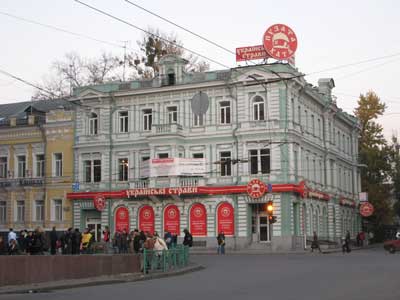
Vol. VII, No. 6, November-December 2007
- Editor's corner
- The changing nature of leisure time
- Who has time to wait?
- Online karting arrives
- Foundations Entertainment University registration is open
- Road kill stew
- Review of IAAPA show in Orlando, Florida
- Grandparent spending
- Free white papers for e-mail marketing
- Death to the black box, hello daylight
- Hurray for pizza
- The relationship of education to income
- Get real, this is a place for children?
- Update on uWink
Editor's corner
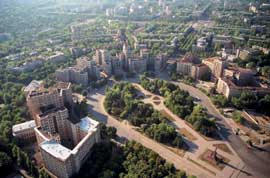  One landmark of Kharkiv is Freedom Square(Ploshchad Svobody), which is currently the second largest city square in Europe, and the 7th largest square in the world. |
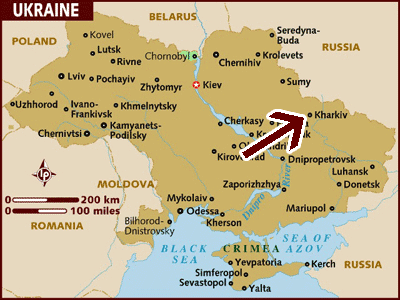 October took me back to Eastern Europe and Russia, to the cities of Kiev and Kharkiv in Ukraine and Moscow in Russia. I thought I'd give a little coverage to the last two cities in this eNewsletter.
October took me back to Eastern Europe and Russia, to the cities of Kiev and Kharkiv in Ukraine and Moscow in Russia. I thought I'd give a little coverage to the last two cities in this eNewsletter.
Most people in the West have probably never heard of Kharkiv (also spelled Kharkov in English and basically pronounced with more emphasis on the 'h' rather than the 'k' at the beginning of the name). It's the second largest city in the Ukraine after Kiev, with a population of about 1.6 million. Located in northeast Ukraine, it is just 30 kilometers (20 miles) from the Ukraine-Russian border.
Kharkiv is one of the main industrial, cultural and educational centers of Ukraine. Its industry and research specialize on arms production and machinery. There are hundreds of industrial companies in the city including world famous giants like the Morozov Machine Building Design Bureau and the Malyshev Factory, leaders in tank production since the 1930s; Hartron (aerospace and nuclear electronics); and the Turboatom turbines producer, part of the Ukraine's nuclear power industry.
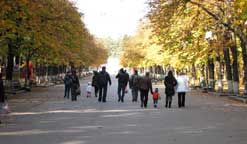 I found Kharkiv had many similarities to Odessa, which I covered in the last eNewsletter issue. There were lots of trees and parks. One person I met referred to the parks as the city's lungs. The independent Ukraine is only 16 years old and went through serious economic times after the split from the Soviet Union, but Kharkiv is finally starting to grow. In fact, Kharkiv may currently be the only Ukrainian city with a higher birth rate than death rate. Buildings are being renovated and there are villas (homes) under construction in what Kharkivians refer to as the "sleeping regions, which would be called the suburbs in the West.
I found Kharkiv had many similarities to Odessa, which I covered in the last eNewsletter issue. There were lots of trees and parks. One person I met referred to the parks as the city's lungs. The independent Ukraine is only 16 years old and went through serious economic times after the split from the Soviet Union, but Kharkiv is finally starting to grow. In fact, Kharkiv may currently be the only Ukrainian city with a higher birth rate than death rate. Buildings are being renovated and there are villas (homes) under construction in what Kharkivians refer to as the "sleeping regions, which would be called the suburbs in the West.
Language can reveal a lot about a place and culture. The term sleeping regions fits the city better than suburbs, as Kharkiv has a very strong central city where most businesses and the serious shopping are located. The outlying areas are truly mostly for sleeping, not work.
The city has a 22-mile underground metro system with 28 stations that was very clean and efficient. It costs only 15¢ to ride and is widely used. Like much of the former Soviet Union, much of the housing and flats are located in high-rise buildings. This tends to make cities more compact, compared to some of the sprawling cities in America.
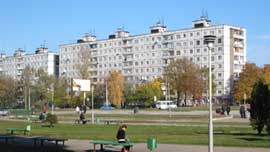
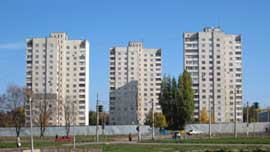
The following is a slide show of some of the buildings found in the central city area:
Ukraine is an interesting country from the standpoint of being so young. It is still forming its national identity. The eastern part of the country still feels strong ties to mother Russia, where Russian is predominately spoken. People in the western part of the country predominately speak Ukrainian and are pushing to be allied with the West and eventually become a member of the European Union. In fact, in a sense, Ukraine is a country in its teenage years, trying to find its individual identity. There is some longing for the security of past conditions, which were not good, but constant and predictable, during the Soviet Union days. Everyone at least knew they had a job.
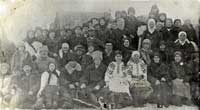
Residents of Krasylivka who survived the devastating 1932-33 Holodomor famine, pose for a group photo made in 1934 in the village of Krasylivka, Ukraine. In Krasylivka as many as 1,017 people, roughly the village's present day population, died during the famine
But Ukrainians are also coming to terms with the horrors of Soviet rule, especially the Holodomor (death by hunger), a Soviet engineered famine in 1932-33 that saw Ukraine's agricultural wealth requisitioned at gunpoint as part of Stalin's plan to force peasants onto collective farms. Millions died of starvation as a result. For decades, Soviet authorities downplayed the tragedy, claiming it was a natural disaster. This past Saturday, November 24th, Ukraine officially celebrated the 75th anniversary of the Holodomor. The Ukrainian government has already declared the famine genocide. So have the United States and some other countries. But Russia, the legal successor to the Soviet state, refuses to concede to that label.
And mother Russia seems to be having difficulties with teenage Ukraine, much as a mother finds it hard when her children go off on their own. Last year, Russia got upset with Ukraine's movement to ally itself with the West and away from Russia's political influence. Russia's state-owned gas supplierGazprom cut off natural gas supplies for four days until a compromise was worked out. Gazprom once again threatened to cut off natural gas supplies on October 2, 2007; observers conn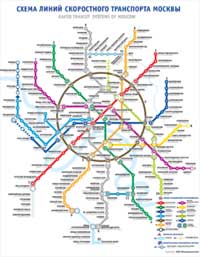 ected this threat to the results of parliamentary elections in Ukraine. To bolster regional energy security and reduce the region's dependence on Russia for its energy supplies, Ukraine, in cooperation with Azerbaijan, Georgia, Poland and Lithuania, have joined together to build an oil pipeline linking the Baltic and Black seas.
ected this threat to the results of parliamentary elections in Ukraine. To bolster regional energy security and reduce the region's dependence on Russia for its energy supplies, Ukraine, in cooperation with Azerbaijan, Georgia, Poland and Lithuania, have joined together to build an oil pipeline linking the Baltic and Black seas.
And speaking of Russia, you can never really appreciate Moscow without seeing and experiencing it in person. The stories about the terrible traffic are absolutely true. Someday in the near future, it is highly possible that gridlock will bring all vehicles to a stop. The problem is being fueled by a booming economy and rapidly expanding middle and upper classes, which all buy and drive cars.
The famous Moscow Metro is a whole different story. Fast and efficient, it spans almost the entire Russian capital, and is one of the world's most heavily used metro systems. It is well known for the ornate design of many of its stations, which contain beautiful examples of Socialist realist architecture, perhaps the most grandiose architectural phenomenon of the Stalinist era.
The first Metro line opened in 1935. Today, the Moscow Metro has 12 lines, 173 stations and is 175 miles (282 kilometers) in total length. On a normal weekday it carries over 7 million passengers.
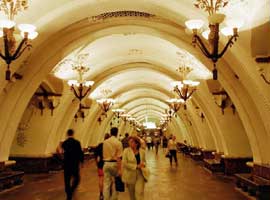 Arbatskaya station |
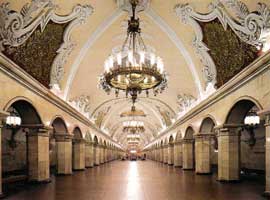 Komsomolskaya-Koltsevaya station |
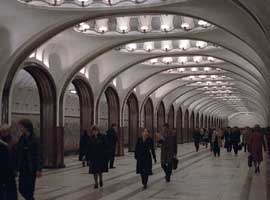 Mayakovskaya station |
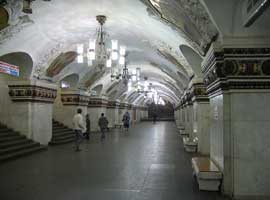 Kievkaya station |
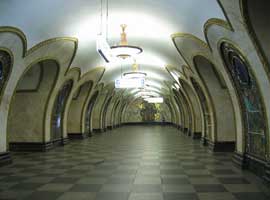 Novoslobodskaya station |
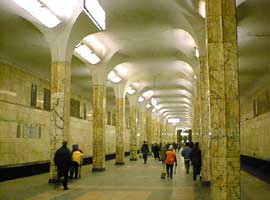 Avtozavodskaya station |
What you can only truly comprehend in person is the grandeur of many of the buildings in central Moscow. This is especially true along Tverskaya Street, the main street that stretches north from Red Square. The buildings are truly an architectural example of power and pride. You can feel the grandeur of the former Soviet Union just looking at them.
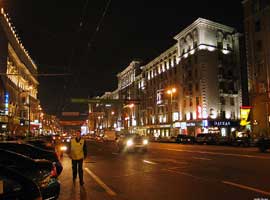 |
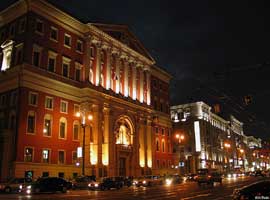 |
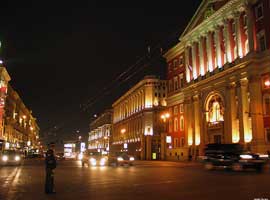 |
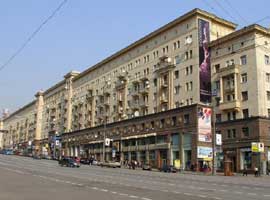 |
And a site on Tverskaya Street not to be missed is the Eliseevkii Food Shop, also know as Eliseev's Gastronome. Named after its former owner, millionaire Gregory Eliseev, the store is renowned not only for its assortment of gourmet foods and wines, but also for it luxurious Neo-Baroque interior with huge crystal chandeliers hanging from 65-foot ceilings.
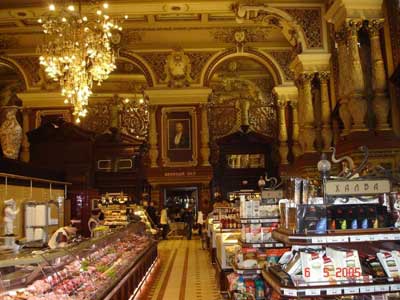
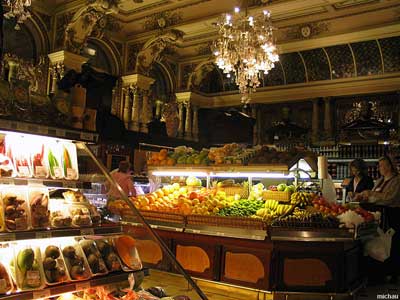
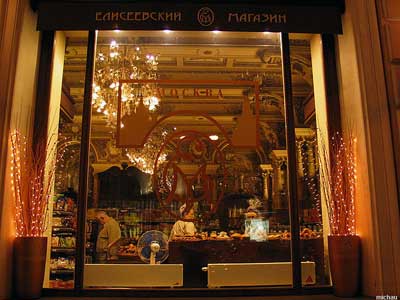
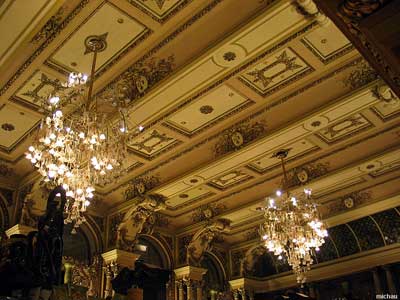
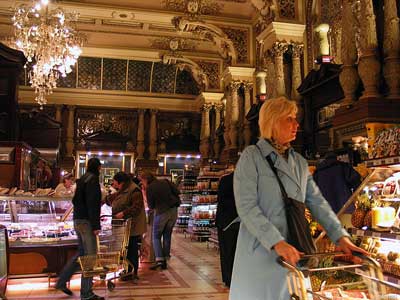
Eliseevkii Food Shop on Tverskaya Street in Moscow
There's only so much space in our eNewsletter to share my travels with you. The balance of this issue is devoted to industry-specific topics — ones you won't find in any other industry publication. We leave it up to the trade publications to tell you about the latest ride, the newest games, which parks just opened, the nuts and bolts of location-based leisure. What you will find in our Leisure eNewsletter are much meatier stories, such as underlying societal trends that are affecting the industry, new concepts you won't read about elsewhere, and continued coverage of food and beverage and eatertainment, which is the future of the community-based entertainment industry.
Nowhere else will you find continual coverage of the changing nature of leisure time, or children's dining and taste preferences, or even the recycling of the entrepreneurial recipe for road kill stew. That's because our company believes that without this type of research, we can't assure our clients a successful future. And we are willing to share some of this information and insight with you, our readers. We accept no advertising, so we have the freedom to tell it the way we see it, and as our regular readers know, that is exactly what we do. That's not a freedom all those trade magazines have, as they can't say anything that might jeopardize their advertising revenue.
Because we do so much research, much of it outside the industry, we spot emerging and nascent trends before the location-based entertainment industry even knows they are happening. For years, we have been discussing the importance of what we call quality-of-place, also known as interior design or atmospherics or the "comfort factor. Finally, in October, Vending Times magazine ran a story on its importance. That same story also gave us credit for identifying and naming the 'tainment' trend, all those other types of venues now incorporating entertainment into their offerings and creating serious competition to predominately entertainment-only venues.
And we not only give coverage to emerging trends and new concepts, but we are working on the design and production of facilities that are responding to them, as well as the many emerging 'tainment' venues, including eatertainment, cinema-dining-bowling-entertainment venues, play cafés and experiential retail.
Although we are publishing only about every other month, we somehow manage to really pack in the stories. This issue breaks the record, at least in word count. It's amazing what you can accomplish on a round-trip flight with 28 hours of flying time. Print out a copy of the eNewsletter and digest it over time. But don't overlook the many URL links we add, so you can dig a little deeper or learn a little more about something we mention. All our eNewsletters are archived on our website back to 2001, so you can always go online to use the URL links or read previous issues.
Randy White
Editor
Vol. VII, No. 6, November-December 2007
- Editor's corner
- The changing nature of leisure time
- Who has time to wait?
- Online karting arrives
- Foundations Entertainment University registration is open
- Road kill stew
- Review of IAAPA show in Orlando, Florida
- Grandparent spending
- Free white papers for e-mail marketing
- Death to the black box, hello daylight
- Hurray for pizza
- The relationship of education to income
- Get real, this is a place for children?
- Update on uWink


